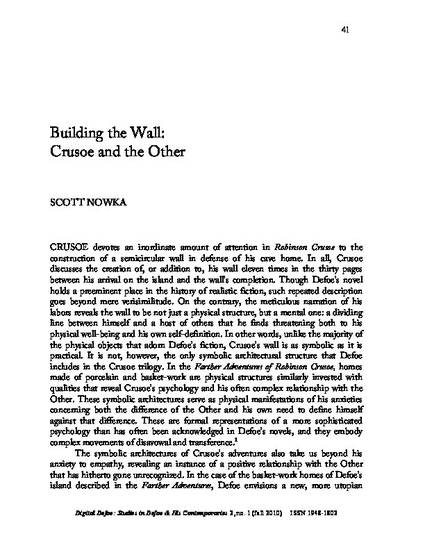
Article
Building the Wall: Crusoe and the Other
Digital Defoe
(2010)
Abstract
Crusoe devotes an inordinate amount of attention in Robinson Crusoe to the construction of a semicircular wall in defense of his cave home. In all, Crusoe discusses the creation of, or addition to, his wall eleven times in the thirty pages between his arrival on the island and the wall’s completion. Though Defoe’s novel holds a preeminent place in the history of realistic fiction, such repeated description goes beyond mere verisimilitude. On the contrary, the meticulous narration of his labors reveals the wall to be not just a physical structure, but a mental one: a dividing line between himself and a host of others that he finds threatening both to his physical well-being and his own self-definition. In other words, unlike the majority of the physical objects that adorn Defoe’s fiction, Crusoe’s wall is as symbolic as it is practical. It is not, however, the only symbolic architectural structure that Defoe includes in the Crusoe trilogy. In the Farther Adventures of Robinson Crusoe, homes made of porcelain and basket-work are physical structures similarly invested with qualities that reveal Crusoe’s psychology and his often complex relationship with the Other. These symbolic architectures serve as physical manifestations of his anxieties concerning both the difference of the Other and his own need to define himself against that difference. These are formal representations of a more sophisticated psychology than has often been acknowledged in Defoe’s novels, and they embody complex movements of disavowal and transference.
Disciplines
Publication Date
2010
Citation Information
Scott Nowka. "Building the Wall: Crusoe and the Other" Digital Defoe Vol. 2 Iss. 1 (2010) p. 41 - 58 ISSN: 1948-1802 Available at: http://works.bepress.com/scott-nowka/3/
Creative Commons license

This work is licensed under a Creative Commons CC_BY-NC-ND International License.
